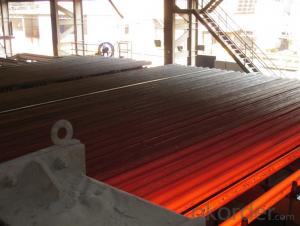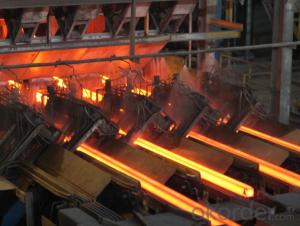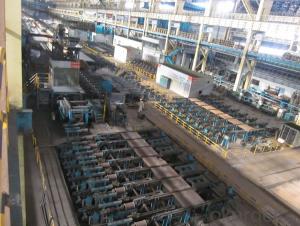Square Steel Billet Q235/3SP Grade Prime Quality 10#
- Loading Port:
- Tianjin
- Payment Terms:
- TT OR LC
- Min Order Qty:
- 2000 m.t
- Supply Capability:
- 50000 m.t/month
OKorder Service Pledge
OKorder Financial Service
You Might Also Like
Description of Square Steel Billet Q235/3SP Grade Prime Quality 10#
M. S. Billets are used for rolling of TMT Re-Bars of Fe415 and Fe500 Grade and various other structural steel products.
CRS Billets are used for rolling of CRS TMT Re-Bars.
Special Alloy Billets are used for rolling of any special grade TMT Re-Bars like Earthquake resistant TMT Re-Bars and for special grade structural steel products.
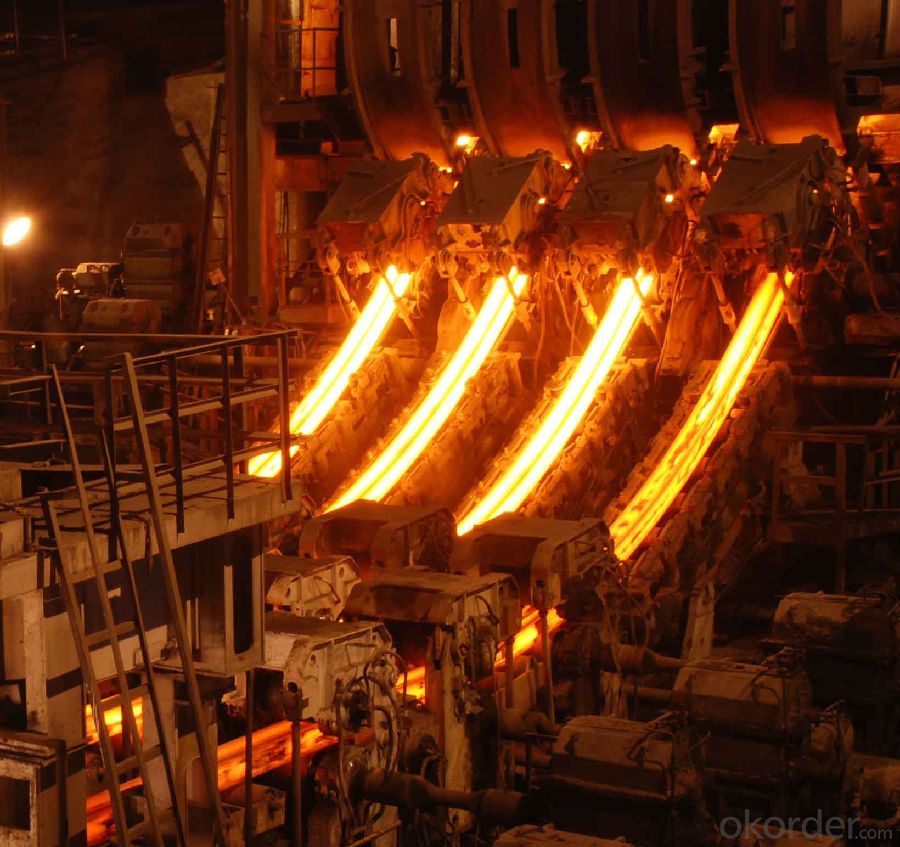
Main Feature Square Steel Billet Q235/3SPGrade Prime Quality 10#
Raw elements(C,Fe,Ni,Mn,Cr,Cu.)---Smelted ingots by AOD finery---hot rolled into black suface---pickling in acid liquid---cold drawn----polished by automatically machine--- cutting into pieces---checking quanlity
Applications of Square Steel Billet Q235/3SP Grade Prime Quality 10#
Widely Used in the areas such as Stainless Steel Fasteners, Chains, Kitchen and Sanitary wares, Furniture handles, Handrails, Electroplating and Electrolyzing pendants, Foods, Electron, Petroleum, Construction and Decoration, etc. Products have a high strength after cold-working. Electronic products parts, Medical appliance, Springs, Bus Inside and Outside packaging and building, Street Lamp Posts, etc. Decoration materials and Outdoor Publicity Billboard. Used for the products which have the Anti-Stress Corrosion requirement. Electron Products, Table-wares, Bolts, Nuts, Screen Meshes, Cumbustors and so on.
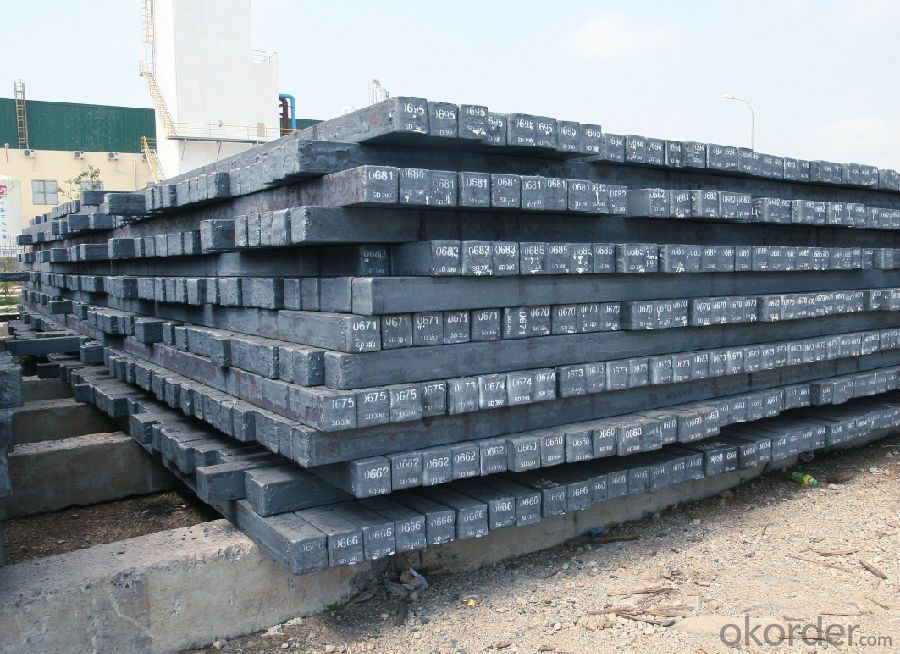
Specifications of Square Steel Billet Q235/3SP Grade Prime Quality 10#
| Standard | C(%) | Mn(%) | S(%) | P(%) | Si(%) |
| Q195 | ≤0.12 | ≤0.50 | ≤0.040 | ≤0.035 | ≤0.30 |
| Q235 | ≤0.20 | ≤1.40 | ≤0.045 | ≤0.045 | ≤0.35 |
| Q275 | ≤0.22 | ≤1.50 | ≤0.045 | ≤0.045 | ≤0.35 |
| 20MnSi | 0.17-0.25 | 1.2-1.6 | ≤ 0.050 | ≤ 0.050 | 0.40-0.80 |
| 3SP | 0.14-0.22 | 0.40-0.85 | ≤ 0.050 | ≤ 0.040 | 0.05-0.15 |
| 5SP | 0.28-0.37 | 0.50-1.00 | ≤ 0.050 | ≤ 0.040 | 0.15-0.30 |
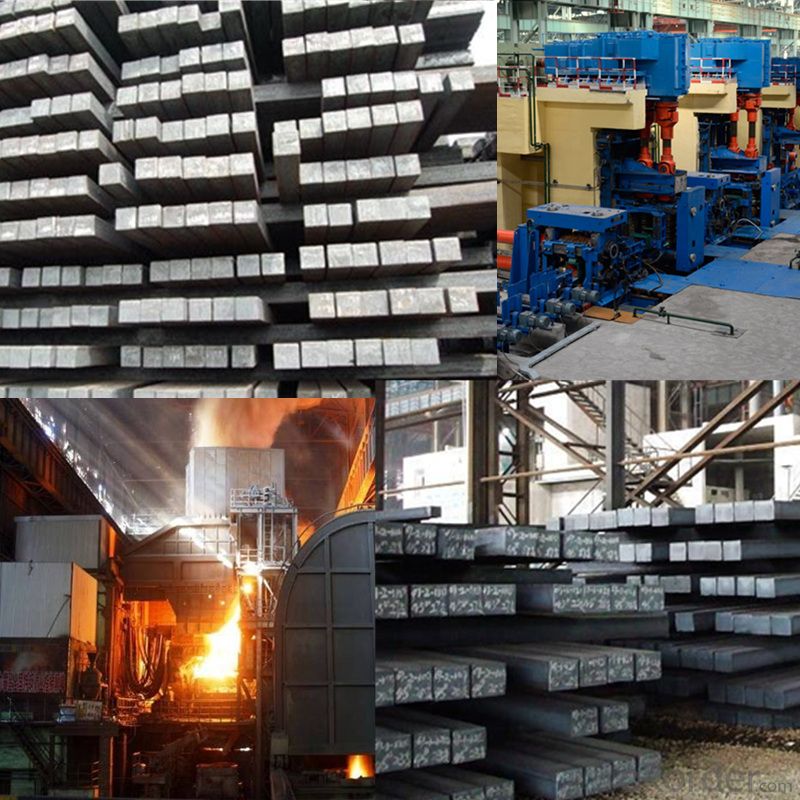
FAQ of Square Steel Billet Q235/3SP Grade Prime Quality 10#
We have organized several common questions for our clients,may help you sincerely:
1. How Can I Visit There?
Our company is located in Tianjin City, China, near Beijing. You can fly to Tianjin Airport Directly. All our clients, from home or aboard, are warmly welcome to visit us!
2. How Can I Get Some Sample?
We are honored to offer you sample.
3. Why choose CNBM?
Our delivery time about 15-20days for standard sizes, if you have other requirements like hardness, quanity and width ,it is about 20-40days. But don't worry we also try our best for the delivery time ,because time longer and our cost is higher.
- Q:How are steel billets used in the production of oil and gas exploration equipment?
- Steel billets are commonly used in the production of oil and gas exploration equipment due to their strength and durability. These billets are shaped and machined into various components such as valves, pumps, drilling tools, and pipelines, which are crucial for the extraction and transportation of oil and gas. The high-quality steel ensures that the equipment can withstand harsh operating conditions, including high temperatures, pressure, and corrosive environments, thereby ensuring the safety and reliability of oil and gas exploration operations.
- Q:How do steel billets contribute to the manufacturing of furniture and fixtures?
- Steel billets are an essential component in the manufacturing of furniture and fixtures due to their unique properties that make them versatile and durable. Firstly, steel billets provide the necessary strength and stability required for the construction of furniture and fixtures. They act as a sturdy framework that supports the weight and load-bearing capacity of these items, ensuring their long-lasting functionality. Additionally, the malleability of steel billets allows for intricate designs and shapes to be formed, adding aesthetic appeal to furniture and fixtures. This flexibility in design enables manufacturers to create a wide range of styles and patterns that suit various consumer preferences and interior design themes. Furthermore, steel billets can be easily welded, making them ideal for joining different components together during the manufacturing process. This welding capability ensures a seamless and secure construction, enhancing the overall quality and durability of the furniture and fixtures. Moreover, steel billets possess corrosion-resistant properties, which make them suitable for both indoor and outdoor furniture and fixtures. This resistance to rust and decay ensures that these items can withstand harsh environmental conditions, maintaining their appearance and structural integrity over time. In conclusion, steel billets play a crucial role in the manufacturing of furniture and fixtures. Their strength, malleability, weldability, and corrosion resistance contribute to the durability, design flexibility, and longevity of these items, making them a preferred choice for both manufacturers and consumers alike.
- Q:How long do steel billets typically last?
- Steel billets typically last for many years, as they are highly durable and resistant to corrosion. However, the specific lifespan of a steel billet depends on various factors such as the quality of the steel, the environment it is exposed to, and the usage conditions. With proper maintenance and care, steel billets can last for several decades.
- Q:What are the main challenges in the quality control of steel billets?
- Several factors can affect the quality and performance of steel billets, posing significant challenges in their quality control. Here, we outline some key obstacles in this regard: 1. Chemical Composition: The accurate chemical composition of steel billets is pivotal in determining their strength, durability, and mechanical properties. However, ensuring consistent chemical composition is challenging due to variations in raw materials, melting processes, and the presence of impurities. 2. Homogeneity: It is crucial to achieve uniformity in the microstructure and composition throughout the steel billet. Inadequate mixing or non-uniform cooling can lead to inconsistencies, resulting in weak areas and uneven mechanical properties. 3. Defect Detection: Detecting and eliminating defects in steel billets is essential to prevent failures during subsequent processing and usage. Common defects include cracks, inclusions, segregation, porosity, and surface irregularities. However, accurately and promptly detecting these defects can be challenging due to their size, complexity, and location. 4. Dimensional Accuracy: Consistency in the dimensions and shape of steel billets is vital for their further processing and use in various applications. Maintaining precise dimensions requires controlling variables such as casting speed, cooling rates, and mold design. 5. Surface Quality: The condition of the surface of steel billets is critical for subsequent operations like rolling, forging, or machining. Ensuring a smooth, clean, and defect-free surface is challenging due to factors such as scale formation, oxidation, decarburization, and surface contamination during handling and storage. 6. Heat Treatment: Proper heat treatment is often necessary to achieve the desired mechanical properties in steel billets. However, controlling the heating and cooling rates, as well as the soaking times, can be challenging due to variations in equipment, temperature monitoring, and quenching techniques. 7. Traceability: Maintaining traceability and documentation throughout the production process is crucial for quality control. Tracking the origin of raw materials, process parameters, testing records, and certifications can be challenging, especially in complex supply chains. To address these challenges in the quality control of steel billets, a combination of advanced testing techniques, robust process controls, skilled personnel, and continuous improvement initiatives is necessary.
- Q:What are the different types of cutting techniques used for steel billets?
- Different cutting techniques are employed for steel billets, depending on the specific requirements of the project. Several commonly used techniques include: 1. Sawing: This traditional and widely utilized method involves cutting through the steel billet using a saw blade. It can be done manually or with automated sawing machines, making it suitable for both small and large billets. 2. Flame Cutting: Also known as oxy-fuel cutting, this technique employs a flame torch to heat the steel to its kindling temperature. Then, a jet of oxygen is introduced to burn through the metal. It is frequently used for cutting thicker billets and can be performed manually or with CNC-controlled equipment. 3. Plasma Cutting: By utilizing a high-velocity jet of ionized gas, plasma cutting melts and blows away the steel. This technique is particularly effective for cutting billets with complex shapes or contours. It is often automated and produces clean and precise cuts. 4. Waterjet Cutting: This technique involves the use of a high-pressure jet of water combined with abrasive particles to cut through the steel billet. It is ideal for materials sensitive to heat, as it minimizes heat-affected zones. Waterjet cutting is capable of handling various thicknesses and shapes of billets. 5. Laser Cutting: Laser cutting employs a high-powered laser beam to melt and vaporize the steel, resulting in a clean and precise cut. It is highly accurate and suitable for cutting intricate shapes and designs. Laser cutting is commonly automated and widely used in industrial settings. Factors such as desired precision, speed, material thickness, and budget must be considered when selecting the most appropriate cutting technique for steel billets. Each technique has its own advantages and limitations, and choosing the right one can significantly impact the quality and efficiency of the cutting process.
- Q:How are steel billets used in the production of pipes?
- Steel billets are melted and then cast into a solid form, which is then rolled or forged to form pipes of various sizes and shapes. These billets serve as the raw material for the pipe production process and are essential in ensuring the strength, durability, and structural integrity of the pipes.
- Q:What are the common applications of stainless steel billets?
- Stainless steel billets are widely used in various industries due to their exceptional properties and versatility. Some of the common applications of stainless steel billets include: 1. Construction: Stainless steel billets are extensively used in the construction industry for structural purposes. They are used to manufacture beams, columns, and other load-bearing components due to their high strength and corrosion resistance. 2. Automotive Industry: Stainless steel billets find applications in the automotive industry for manufacturing various components like exhaust systems, engine parts, and suspension components. The high temperature and corrosion resistance of stainless steel make it an ideal choice for these applications. 3. Aerospace Industry: Stainless steel billets are used in the aerospace industry to manufacture critical components like aircraft frames, landing gear, and engine parts. The high strength-to-weight ratio and resistance to extreme temperatures make stainless steel a preferred material in this sector. 4. Oil and Gas Industry: Stainless steel billets are widely used in the oil and gas industry due to their excellent corrosion resistance. They are used to manufacture pipes, fittings, valves, and other equipment that come in contact with corrosive fluids or gases. 5. Food Processing Industry: Stainless steel billets are extensively used in the food processing industry due to their hygienic properties and resistance to corrosion caused by food and cleaning agents. They are used to manufacture equipment like storage tanks, conveyors, and processing machinery. 6. Medical and Pharmaceutical Industry: Stainless steel billets find applications in the medical and pharmaceutical industry for manufacturing surgical instruments, implants, and equipment. The biocompatibility and sterilization capabilities of stainless steel make it suitable for these critical applications. 7. Marine Industry: Stainless steel billets are used in the marine industry for manufacturing various components like ship hulls, propellers, and fittings. The corrosion resistance of stainless steel is crucial in the harsh saltwater environment. 8. Power Generation Industry: Stainless steel billets are used in power plants for manufacturing boilers, heat exchangers, and turbine components. The high-temperature and corrosion resistance properties of stainless steel make it suitable for these demanding applications. In summary, stainless steel billets have a wide range of applications across industries due to their exceptional properties like strength, corrosion resistance, and temperature resistance. From construction and automotive to aerospace and medical sectors, stainless steel billets play a vital role in manufacturing critical components and equipment.
- Q:What are the different types of surface defect detection methods for steel billets?
- Steel billets are subject to various methods of surface defect detection. Among the techniques commonly used are visual inspection, magnetic particle inspection, ultrasonic testing, eddy current testing, and laser scanning. 1. The simplest and most traditional method is visual inspection, where trained inspectors visually examine the surface of steel billets for cracks, scratches, or foreign material. 2. Magnetic Particle Inspection (MPI) is a non-destructive testing method that uses magnetic fields and iron particles to detect surface defects. The billet is magnetized, and iron particles are applied to the surface. Any defect causes a leakage of magnetic flux, attracting the iron particles and forming visible indications. 3. Ultrasonic Testing (UT) utilizes high-frequency sound waves to detect internal and surface defects in steel billets. Ultrasonic waves are emitted into the billet by a transducer, and the reflected waves are analyzed to identify flaws or irregularities. 4. Eddy Current Testing (ECT) makes use of electromagnetic induction to detect surface defects. A coil carrying an alternating current is placed near the billet's surface, generating eddy currents. Any variation in the surface, such as cracks or corrosion, alters the eddy currents, which are then detected by the instrument. 5. Laser Scanning is a relatively advanced method that employs laser technology to scan the surface of steel billets. The laser beam reflects off the surface, and a sensor analyzes the reflected light to identify surface defects like scratches or dents. These methods differ in terms of sensitivity, speed, and cost-effectiveness. The selection of the appropriate surface defect detection method depends on factors such as the required level of accuracy, the types of defects to be detected, and the specific requirements of the industry.
- Q:How do steel billets contribute to the overall noise reduction of a structure?
- There are several ways in which steel billets can help reduce the overall noise in a structure. Firstly, they are commonly used in constructing walls, floors, and ceilings, which are important components for sound insulation. Steel's density and rigidity effectively block and absorb sound waves, preventing them from passing through and reducing noise transmission. Moreover, steel billets can be employed to make acoustic panels that are specifically designed to enhance sound absorption and reduce reverberation within a space. These panels can be strategically placed in areas where noise is a concern, such as conference rooms, auditoriums, or music studios. By incorporating steel billets into these panels, their acoustic properties are improved, resulting in better noise reduction. Additionally, steel billets can be utilized in manufacturing doors and windows. These elements often contribute to sound leakage due to their vulnerability to vibrations and poor sealing. By using steel billets in their construction, the doors and windows become stronger and more stable, reducing the amount of sound that can pass through them. Furthermore, employing steel frames and gaskets can create a tighter seal, further minimizing noise infiltration. In conclusion, steel billets contribute to the overall noise reduction of a structure by providing the necessary density, rigidity, and acoustic properties to effectively block, absorb, and reduce sound transmission. Whether used in construction materials, acoustic panels, or doors and windows, steel billets play a vital role in creating a quieter and more comfortable environment.
- Q:What is the role of steel billets in the manufacturing of automotive suspension systems?
- Steel billets play a crucial role in the manufacturing of automotive suspension systems. Suspension systems are responsible for providing a smooth and comfortable ride while ensuring the vehicle's stability and handling. Steel billets are used as a raw material to fabricate various components of the suspension system, such as control arms, coil springs, sway bars, and stabilizer links. One of the primary requirements of suspension systems is strength and durability. Steel billets, due to their high tensile strength and excellent mechanical properties, are an ideal choice for manufacturing suspension components. These billets are typically made from carbon steel, which offers exceptional strength and can withstand the heavy loads and forces experienced by suspension systems. The process of manufacturing suspension components from steel billets involves several stages. Firstly, the billets are heated to a specific temperature, typically above their recrystallization temperature, to make them more malleable. This allows the material to be easily shaped and formed into the desired component. Once heated, the billets are subjected to various forming processes, such as hot forging, cold forging, or machining, depending on the specific component being manufactured. These processes help shape the billets into control arms, coil springs, or other suspension components with precise dimensions and specifications. The use of steel billets in suspension systems offers several advantages. Firstly, steel is a cost-effective material, making the overall manufacturing process more economical. Additionally, steel provides excellent strength-to-weight ratio, allowing for lighter suspension components without compromising on strength and durability. This, in turn, contributes to improved fuel efficiency and overall vehicle performance. Moreover, steel billets have high resistance to wear, corrosion, and fatigue, ensuring that the suspension components can withstand the harsh operating conditions and last for a long time. They also offer excellent damping characteristics, helping to absorb and dissipate vibrations and shocks, further enhancing the ride comfort and stability of the vehicle. In conclusion, steel billets are essential in the manufacturing of automotive suspension systems. Their strength, durability, and malleability make them an ideal raw material for fabricating various suspension components. By utilizing steel billets, automotive manufacturers can produce suspension systems that provide a smooth ride, stability, and enhanced performance, contributing to overall driver and passenger comfort and safety.
1. Manufacturer Overview |
|
|---|---|
| Location | |
| Year Established | |
| Annual Output Value | |
| Main Markets | |
| Company Certifications | |
2. Manufacturer Certificates |
|
|---|---|
| a) Certification Name | |
| Range | |
| Reference | |
| Validity Period | |
3. Manufacturer Capability |
|
|---|---|
| a)Trade Capacity | |
| Nearest Port | |
| Export Percentage | |
| No.of Employees in Trade Department | |
| Language Spoken: | |
| b)Factory Information | |
| Factory Size: | |
| No. of Production Lines | |
| Contract Manufacturing | |
| Product Price Range | |
Send your message to us
Square Steel Billet Q235/3SP Grade Prime Quality 10#
- Loading Port:
- Tianjin
- Payment Terms:
- TT OR LC
- Min Order Qty:
- 2000 m.t
- Supply Capability:
- 50000 m.t/month
OKorder Service Pledge
OKorder Financial Service
Similar products
New products
Hot products
Related keywords
